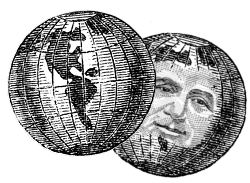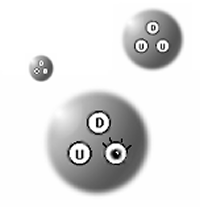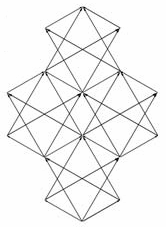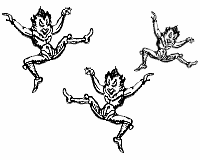 OUP Blog has a sort of preview by Bruntrup and Jaskolla of their forthcoming collection on panpsychism, due out in December, with a video of David Chalmers at the end: they sort of credit him with bringing panpsychist thought into the mainstream. I’m using ‘panpsychism’ here as a general term, by the way, covering any view that says consciousness is present in everything, though most advocates really mean that consciousness or experience is everywhere, not souls as the word originally implied.
OUP Blog has a sort of preview by Bruntrup and Jaskolla of their forthcoming collection on panpsychism, due out in December, with a video of David Chalmers at the end: they sort of credit him with bringing panpsychist thought into the mainstream. I’m using ‘panpsychism’ here as a general term, by the way, covering any view that says consciousness is present in everything, though most advocates really mean that consciousness or experience is everywhere, not souls as the word originally implied.
I found the piece interesting because they put forward two basic arguments for panpsychism, both a little different from the desire for simplification which I’ve always thought was behind it – although it may come down to the same basic ideas in the end.
The first argument they suggest is that ‘nothing comes of nothing’; that consciousness could not have sprung out of nowhere, but must have been there all along in some form. In this bald form, it seems to me that the argument is virtually untenable. The original Scholastic argument that nothing comes of nothing was, I think, a cosmological argument. In that form it works. If there really were nothing, how could the Universe get started? Nothing happens without a cause, and if there were nothing, there could be no causes. But within an existing Universe, there’s no particular reason why new composite or transformed entities cannot come into existence. The thing that causes a new entity need not be of the same kind as that entity; and in fact we know plenty of new things that once did not exist but do now; life, football, blogs.
So to make this argument work there would have to be some reason to think that consciousness was special in some way, a way that meant it could not arise out of unconsciousness. But that defies common sense, because consciousness coming out of unconsciousness is something we all experience every day when we wake up; and if it couldn’t happen, none of us would be here as conscious beings at all because we couldn’t have been born., or at least, could never have become aware.
Bruntrup and Jaskolla mention arguments from Nagel and William James; Nagel’s, I think rests on an implausible denial of emergentism; that is, he denies that a composite entity can have any interesting properties that were not present in the parts. The argument in William James is that evolution could not have conferred some radically new property and that therefore some ‘mind dust’ must have been present all the way back to the elementary particles that made the world.
I don’t find either contention at all appealing, so I may not be presenting them in their best light; the basic idea, I think is that consciousness is just a different realm or domain which could not arise from the physical. Although individual consciousnesses may come and go, consciousness itself is constant and must be universal. Even if we go some way with this argument I’d still rather say that the concept of position does not apply to consciousness than say it must be everywhere.
The second major argument is one from intrinsic nature. We start by noticing that physics deals only with the properties of things, not with the ‘thing in itself’. If you accept that there is a ‘thing in itself’ apart from the collection of properties that give it its measurable characteristics, then you may be inclined to distinguish between its interior reality and its external properties. The claim then is that this interior reality is consciousness. The world is really made of little motes of awareness.
This claim is strangely unmotivated in my view. Why shouldn’t the interior reality just be the interior reality, with nothing more to be said about it? If it does have some other character it seems to me as likely to be cabbagey as conscious. Really it seems to me that only someone who was pretty desperately seeking consciousness would expect to find it naturally in the ding an sich. The truth seems to be that since the interior reality of things is inaccessible to us, and has no impact on any of the things that are accessible, it’s a classic waste of time talking about it.
Aha, but there is one exception; our own interior reality is accessible to us, and that, it is claimed, is exactly the mysterious consciousness we seek. Now, moreover, you see why it makes sense to think that all examples of this interiority are conscious – ours is! The trouble is, our consciousness is clearly related to the functioning of our brain. If it were just the inherent inner property of that brain, or of our body, it would never go away, and unconsciousness would be impossible. How can panpsychists sleep at night? If panpsychism is true, even a dead brain has the kind of interior awareness that the theory ascribes to everything. In other words, my human consciousness is a quite different thing from the panpsychist consciousness everywhere; somehow in my brain the two sit alongside without troubling each other. My consciousness tells us nothing about the interiority of objects, nor vice versa: and my consciousness is as hard to explain as ever.
Maybe the new book will have surprising new arguments? I doubt it, but perhaps I’ll put it on my Christmas present list.




 Panpsychism, or perhaps it would be more accurate to say panexperientialism, has seemed to be quite a popular view in previous discussions here, but I’ve always found it problematic. Panexperientialism, as the name suggests, is the belief that experience is everywhere; that experience is the basis of reality, out of which everything else is built. Objects which seem dead and inanimate ultimately consist of experience just as much as we do: it just doesn’t seem like that because the experiences which make them up are not our experiences. The attractive feature of this view is that it removes some of the mystery from consciousness: instead of being a very rare phenomenon which only occurs in very specific circumstances, such as those which exist in our brains, consciousness of a sort is universal, and so it’ s not at all surprising that we ourselves are conscious.
Panpsychism, or perhaps it would be more accurate to say panexperientialism, has seemed to be quite a popular view in previous discussions here, but I’ve always found it problematic. Panexperientialism, as the name suggests, is the belief that experience is everywhere; that experience is the basis of reality, out of which everything else is built. Objects which seem dead and inanimate ultimately consist of experience just as much as we do: it just doesn’t seem like that because the experiences which make them up are not our experiences. The attractive feature of this view is that it removes some of the mystery from consciousness: instead of being a very rare phenomenon which only occurs in very specific circumstances, such as those which exist in our brains, consciousness of a sort is universal, and so it’ s not at all surprising that we ourselves are conscious. I was wondering recently what we could do with all the new computing power which is becoming available. One answer might be calculating phi, effectively a measure of consciousness, which was very kindly drawn to my attention by Christof Koch. Phi is actually a time- and state-dependent measure of integrated information developed by Giulio Tononi in support of the Integrated Information Theory (IIT) of consciousness which he and Koch have championed. Some readable expositions of the theory are
I was wondering recently what we could do with all the new computing power which is becoming available. One answer might be calculating phi, effectively a measure of consciousness, which was very kindly drawn to my attention by Christof Koch. Phi is actually a time- and state-dependent measure of integrated information developed by Giulio Tononi in support of the Integrated Information Theory (IIT) of consciousness which he and Koch have championed. Some readable expositions of the theory are  I see that among the first papers published by the recently-launched journal of
I see that among the first papers published by the recently-launched journal of